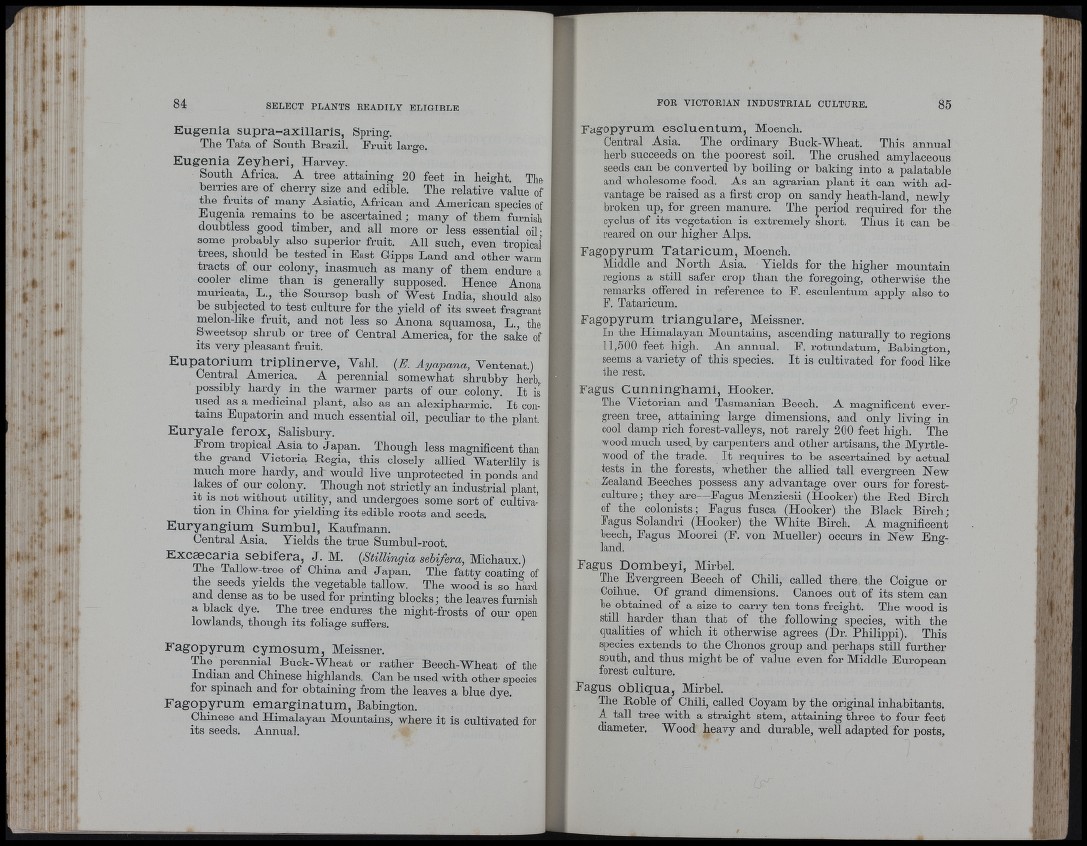
t I
I {
'Mb
¡"iK'i
; I
I''
l*‘
Eugenia supra-axillaris, Spring.
The Tata of South Brazil. Fruit large.
Eugenia Zeyheri, Harvey.
South Africa. A tree attaining 20 feet in height. The
berries are of cherry size and edible. The relative value of
the fruits of many Asiatic, African and American species of
Eugenia remains^ to be ascertained; many of them furnish
doubtless good timber, and all more or less essential oil;
some probably also superior fruit. All such, even tropical
trees, should be tested in East Gipps Land and other warm
tracts of our colony, inasmuch as many of them endure a
cooler clime than is generally supposed. Hence Anona
muricata, L., the Soursop bush of West India, should also
be subjected to test culture for the yield of its sweet fragrant
melon-like fruit, and not less so Anona squamosa, L., the
Sweetsop shrub or tree of Central America, for the sake of
its very pleasant fruit.
Eupatorium triplinerve, Yahl. (A. Ayapana, Ventenat.)
Central America. A perennial somewhat shrubby herb,
possibly hardy in the warmer parts of our colony. It is
used as a medicinal plant, also as an alexipharmic. I t contains
Eupatorin and much essential oil, peculiar to the plant.
Euryale ferox, Salisbury.
From tropical Asia to J apan. Though less magnificent than
the grand Victoria Regia, this closely allied Waterldy is.
much more hardy, and would live unprotected in ponds and
lakes of our colony._ _ Though not strictly an industrial plant,
it is not without utility, and undergoes some sort of cultivation
in China for yielding its edible roots and seeds.
Euryangium Sumbul, Kaufmann.
Central Asia. Yields the true Sumbul-root.
Excaecaria sebifera, J . M. {Stillingia sehifera, Michaux.)
The Tallow-tree of China and Japan. The fatty coating of
the seeds yields the vegetable tallow. The wood is so hard
and dense as to be used for printing blocks; the leaves furnish
a black dye. The tree endures the night-frosts of oim open
lowlands, though its foliage suffers.
Fagopyrum cymosum, Meissner.
The perennial Buck-Wheat or rather Beech-Wheat of the
Indian and Chinese highlands. Can be used with other species
for spinach and for obtaining from tbe leaves a blue dye.
Fagopyrum emarginatum, Babington.
Chinese and Himalayan Mountains, where it is cultivated for
its seeds. Annual.
F a g o p y rum e s c lu e n t u m , Moench.
Central Asia. The ordinary Buck-Wheat. This annual
herb succeeds on the poorest soil. The crushed amylaceous
seeds can be converted by boiling or baking into a palatable
and wholesome food. As an agrarian plant it can with advantage
be raised as a first crop on sandy heath-land, newly
broken up, for green manure. The period required for the
eye I us of its vegetation is extremely short. Thus it can he
reared on our higher Alps.
F a g op y rum Tataricum, Moench.
Middle and North Asia. Yields for the higher mountain
regions a still safer crop than the foregoing, otherwise the
remarks offered in reference to F, esculentum apply also to
F. Tataricum.
F a g op y rum t r la n g u la r e , Meissner.
In the Himalayan Mountains, ascending naturally to regions
11,500 feet high. An annual, F. rotundatum, Babington,
seems a variety of this species. I t is cultivated for food like
the rest.
Fagus Cunningbami, Hooker.
Tlie Victorian and Tasmanian Beech. A magnificent evergreen
tree, attaining large dimensions, and only living in
cool damp rich forest-valleys, not rarely 200 feet high. The
wood much used by carpenters and other artisans, the Myrtle-
wood of the trade. I t requires to be ascertained by actual
tests in the forests, whether the allied tall evergreen New
Zealand Beeches possess any advantage over ours for forest-
culture; they are—Fagus Menziesii (Hooker) the Red Birch
of the colonists; Fagus fusca (Hooker) the Black Birch;
Fagus Solandri (Hooker) the White Birch. A magnificent
beech, Fagus Moorei (F. von Mueller) occurs in New England.
Fagus Dombeyi, Mirbel.
The Evergreen Beech of Chili, called there the Coigue or
Coihne.^ Of grand dimensions. Canoes out of its stem can
he obtained of a size to carry ten tons freight. The wood is
still harder than that of the following species, with the
qualities of which it otherwise agrees (Dr. Philippi). This
species extends to the Chonos group and perhaps still further
south, and thus might be of value even for Middle European
forest culture,
Fagus obliqua, Mirbel.
The Roble of Cbili, called Coyam by the original inhabitants.
A tall tree with a straight stem, attaining three to four feet
diameter. Wood heavy and durable, well adapted for posts.
i I
'’9I*f I
'I I